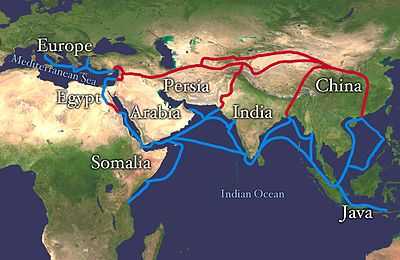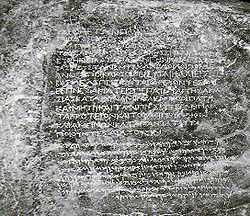Silk Road
| Silk Road | |
|---|---|
|
Main routes of the Silk Road | |
| Route information | |
| Length: | 4,000 mi (6,000 km) |
| Time period: | Around 114 BC – 1450s |
| Official name | Silk Roads: the Routes Network of Chang'an-Tianshan Corridor |
| Type | Cultural |
| Criteria | ii, iii, iv, vi |
| Designated | 2014 (38th session) |
| Reference no. | 1442 |
| State Parties | China, Kazakhstan, Tajikistan, India, Turkey, Persia |
| Region | Asia-Pacific |
| Part of a series on |
| Trade routes |
|---|
The Silk Road, or Silk Route, is a network of trade and cultural transmission routes that were central to cultural interaction through regions of the Asian continent connecting the West and East by merchants, pilgrims, monks, soldiers, nomads, and urban dwellers from China and India to the Mediterranean Sea during various periods of time.[1]
Extending 4,000 miles (6,437 kilometres), the Silk Road derives its name from the lucrative trade in Chinese silk carried out along its length, beginning during the Han dynasty (206 BC – 220 AD). The Central Asian sections of the trade routes were expanded around 114 BC by the Han dynasty, largely through the missions and explorations of Chinese imperial envoy, Zhang Qian.[2] The Chinese took great interest in the safety of their trade products and extended the Great Wall of China to ensure the protection of the trade route.[3]
Trade on the Silk Road was a significant factor in the development of the civilizations of China, the Indian subcontinent, Persia, Europe, the Horn of Africa and Arabia, opening long-distance, political and economic relations between the civilizations.[4] Though silk was certainly the major trade item from China, many other goods were traded, and religions, syncretic philosophies, and various technologies, as well as diseases, also travelled along the Silk Routes. In addition to economic trade, the Silk Road served as a means of carrying out cultural trade among the civilizations along its network.[5]
The main traders during antiquity were the Chinese, Persians, Somalis, Greeks, Syrians, Romans, Armenians, Indians, and Bactrians, and from the 5th to the 8th century the Sogdians. During the coming of age of Islam, Arab traders became prominent.
In June 2014 UNESCO designated the Chang'an-Tianshan corridor of the Silk Road as a World Heritage Site.
Name
The Silk Road derives its name from the lucrative Chinese silk trade, a major reason for the connection of trade routes into an extensive transcontinental network.[6][7] The German terms Seidenstraße and Seidenstraßen ("the Silk Road(s)/Route(s)") were coined by Ferdinand von Richthofen, who made seven expeditions to China from 1868 to 1872.[8][9] Some scholars prefer the term "Silk Routes" because the road included an extensive network of routes, though few were more than rough caravan tracks.
History
Precursors
Cross-continental journeys
As the domestication of pack animals and the development of shipping technology increased the capacity for prehistoric people to carry heavier loads over greater distances, cultural exchanges and trade developed rapidly. In addition, the vast grassland steppes of Asia provided fertile grazing, water, and easy passage for caravans, enabling merchants to travel immense distances, from the shores of the Pacific to Africa and deep into Europe, without trespassing on agricultural lands and arousing hostility.
Chinese and Central Asian contacts
From the 2nd millennium BC, nephrite jade was being traded from mines in the region of Yarkand and Khotan to China. Significantly, these mines were not very far from the lapis lazuli and spinel ("Balas Ruby") mines in Badakhshan, and, although separated by the formidable Pamir Mountains, routes across them were apparently in use from very early times.
The Tarim mummies, mummies of non-Mongoloid, apparently Caucasoid, individuals, have been found in the Tarim Basin, in the area of Loulan located along the Silk Road 200 kilometres (124 miles) east of Yingpan, dating to as early as 1600 BC and suggesting very ancient contacts between East and West. These mummified remains may have been of people who spoke Indo-European languages, which remained in use in the Tarim Basin, in the modern day Xinjiang region, until replaced by Turkic influences from the Xiongnu culture to the north and by Chinese influences from the eastern Han dynasty, who spoke a Sino-Tibetan language.
Some remnants of what was probably Chinese silk have been found in Ancient Egypt from 1070 BC. Though the originating source seems sufficiently reliable, silk unfortunately degrades very rapidly and we cannot double-check for accuracy whether it was actually cultivated silk (which would almost certainly have come from China) that was discovered or a type of "wild silk," which might have come from the Mediterranean region or the Middle East.[10]
Following contacts between metropolitan China and nomadic western border territories in the 8th century BC, gold was introduced from Central Asia, and Chinese jade carvers began to make imitation designs of the steppes, adopting the Scythian-style animal art of the steppes (depictions of animals locked in combat). This style is particularly reflected in the rectangular belt plaques made of gold and bronze with alternate versions in jade and steatite.
The expansion of Scythian cultures, stretching from the Hungarian plain and the Carpathians to the Chinese Kansu Corridor, and linking Iran and the Middle East with Northern India and the Punjab, undoubtedly played an important role in the development of the Silk Road. Scythians accompanied the Assyrian Esarhaddon on his invasion of Egypt, and their distinctive triangular arrowheads have been found as far south as Aswan. These nomadic peoples were dependent upon neighbouring settled populations for a number of important technologies, and in addition to raiding vulnerable settlements for these commodities, they also encouraged long-distance merchants as a source of income through the enforced payment of tariffs. Soghdian Scythian merchants played a vital role in later periods in the development of the Silk Road.
Persian Royal Road
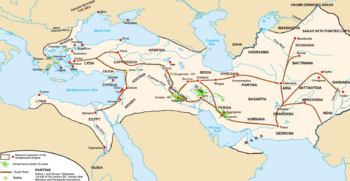
By the time of Herodotus (c. 475 BC), the Royal Road of the Persian Empire ran some 2,857 km (1,775 mi) from the city of Susa on the Karun (250 km (155 mi) east of the Tigris) to the port of Smyrna (modern İzmir in Turkey) on the Aegean Sea.[11] It was maintained and protected by the Achaemenid Empire (c. 500–330 BC) and had postal stations and relays at regular intervals. By having fresh horses and riders ready at each relay, royal couriers could carry messages the entire distance in nine days, while normal travellers took about three months. The Royal Road linked into many other routes. Some of these, such as the routes to India and Central Asia, were also protected by the Achaemenids, which facilitated regular contact between India, Mesopotamia, and the Mediterranean. There are accounts in the biblical Book of Esther of dispatches being sent from Susa, in modern day Iran, to provinces as far out as India and the Kingdom of Kush during the reign of Xerxes the Great (485–465 BC).
Hellenistic era
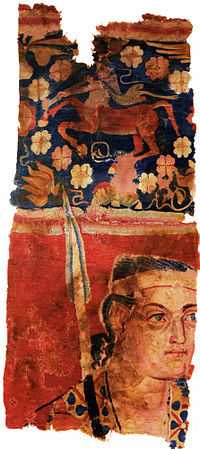
The next major step in the development of the Silk Road was the expansion of the Greek empire of Alexander the Great into Central Asia. In August 329 BC, at the mouth of the Fergana Valley in Tajikistan across the mountain pass from the modern Chinese province of Xinjiang, Alexander founded the city of Alexandria Eschate or "Alexandria The Furthest".[12] This later became a major staging point on the northern Silk Route. See Dayuan (Ta-yuan; Chinese: 大宛; literarily "Great Ionians").
The Greeks remained in Central Asia for the next three centuries, first through the administration of the Seleucid Empire, and then with the establishment of the Greco-Bactrian Kingdom (250 BC-125 BC) in Bactria (modern Afghanistan, Tajikistan, and Pakistan) and the later Indo-Greek Kingdom (180 BC - 10 CE) in modern northern Pakistan and Afghanistan. They continued to expand eastward, especially during the reign of Euthydemus (230–200 BC), who extended his control beyond Alexandria Eschate to Sogdiana. There are indications that he may have led expeditions as far as Kashgar in Chinese Turkestan, leading to the first known contacts between China and the West around 200 BC. The Greek historian Strabo writes, "they extended their empire even as far as the Seres (China) and the Phryni." [13]
The Hellenistic world and Classical Greek philosophy mixed with Eastern philosophies,[14] leading to syncretisms such as Greco-Buddhism, which itself later spread to China along the Silk Road, giving birth to Zen Buddhism. (See Bodhidharma.)
Chinese exploration of Central Asia
With the Mediterranean linked to the Fergana Valley, the next step was to open a route across the Tarim Basin and the Gansu Corridor to China Proper. This extension came around 130 BC, with the embassies of the Han dynasty to Central Asia following the reports of the ambassador Zhang Qian[15] (who was originally sent to obtain an alliance with the Yuezhi against the Xiongnu). After the defeat of the Xiongnu, however, Chinese armies established themselves in Central Asia, initiating the Silk Route as a major avenue of international trade.[16] Some say that the Chinese Emperor Wu became interested in developing commercial relationships with the sophisticated urban civilizations of Ferghana, Bactria, and the Parthian Empire: "The Son of Heaven on hearing all this reasoned thus: Ferghana (Dayuan "Great Ionians") and the possessions of Bactria (Ta-Hsia) and Parthian Empire (Anxi) are large countries, full of rare things, with a population living in fixed abodes and given to occupations somewhat identical with those of the Chinese people, but with weak armies, and placing great value on the rich produce of China" (Hou Hanshu, Later Han History). Others[17] say that Emperor Wu was mainly interested in fighting the Xiongnu and that major trade began only after the Chinese pacified the Hexi Corridor.

The Chinese were also strongly attracted by the tall and powerful horses (named "Heavenly horses") in the possession of the Dayuan (literally the "Great Ionians," the Greek kingdoms of Central Asia), which were of capital importance in fighting the nomadic Xiongnu. The Chinese subsequently sent numerous embassies, around ten every year, to these countries and as far as Seleucid Syria. "Thus more embassies were dispatched to Anxi [Parthia], Yancai [who later joined the Alans ], Lijian [Syria under the Greek Seleucids], Tiaozhi [Chaldea], and Tianzhu [northwestern India]... As a rule, rather more than ten such missions went forward in the course of a year, and at the least five or six." (Hou Hanshu, Later Han History).These connections marked the beginning of the Silk Road trade network that extended to the Roman Empire.[18] The Chinese campaigned in Central Asia on several occasions, and direct encounters between Han troops and Roman legionaries (probably captured or recruited as mercenaries by the Xiong Nu) are recorded, particularly in the 36 BC battle of Sogdiana (Joseph Needham, Sidney Shapiro). It has been suggested that the Chinese crossbow was transmitted to the Roman world on such occasions, although the Greek gastraphetes provides an alternative origin. R. Ernest Dupuy and Trevor N. Dupuy suggest that in 36 BC, a "Han expedition into central Asia, west of Jaxartes River, apparently encountered and defeated a contingent of Roman legionaries. The Romans may have been part of Antony's army invading Parthia. Sogdiana (modern Bukhara), east of the Oxus River, on the Polytimetus River, was apparently the most easterly penetration ever made by Roman forces in Asia. The margin of Chinese victory appears to have been their crossbows, whose bolts and darts seem easily to have penetrated Roman shields and armor."[19] The Roman historian Florus also describes the visit of numerous envoys, which included Seres, to the first Roman Emperor Augustus, who reigned between 27 BC and 14 AD:
Even the rest of the nations of the world which were not subject to the imperial sway were sensible of its grandeur, and looked with reverence to the Roman people, the great conqueror of nations. Thus even Scythians and Sarmatians sent envoys to seek the friendship of Rome. Nay, the Seres came likewise, and the Indians who dwelt beneath the vertical sun, bringing presents of precious stones and pearls and elephants, but thinking all of less moment than the vastness of the journey which they had undertaken, and which they said had occupied four years. In truth it needed but to look at their complexion to see that they were people of another world than ours.— Henry Yule, Cathay and the way thither
The Han army regularly policed the trade route against nomadic bandit forces generally identified as Xiongnu. Han general Ban Chao led an army of 70,000 mounted infantry and light cavalry troops in the 1st century AD to secure the trade routes, reaching far west to the Tarim basin. Ban Chao expanded his conquests across the Pamirs to the shores of the Caspian Sea and the borders of Parthia.[20] It was from here that the Han general dispatched envoy Gan Ying to Daqin (Rome).[21] The Silk Road essentially came into being from the 1st century BCE, following these efforts by China to consolidate a road to the Western world and India, both through direct settlements in the area of the Tarim Basin and diplomatic relations with the countries of the Dayuan, Parthians and Bactrians further west. The Silk Roads were a "complex network of trade routes" that gave people the chance to exchange goods and culture.[22]
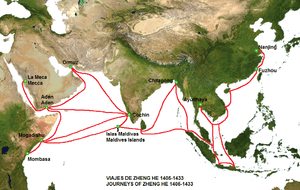
A maritime Silk Route opened up between Chinese-controlled Giao Chỉ (centred in modern Vietnam, near Hanoi), probably by the 1st century. It extended, via ports on the coasts of India and Sri Lanka, all the way to Roman-controlled ports in Egypt and the Nabataean territories on the northeastern coast of the Red Sea.
Roman Empire

Soon after the Roman conquest of Egypt in 30 BC, regular communications and trade between China, Southeast Asia, India, the Middle East, Africa, and Europe blossomed on an unprecedented scale. The eastern trade routes from the earlier Hellenistic powers and the Arabs that were part of the Silk Road were inherited by the Roman Empire. With control of these trade routes, citizens of the Roman Empire would receive new luxuries and greater prosperity for the Empire as a whole.[24] The Greco-Roman trade with India started by Eudoxus of Cyzicus in 130 BC continued to increase, and according to Strabo (II.5.12), by the time of Augustus, up to 120 ships were setting sail every year from Myos Hormos in Roman Egypt to India.[25] The Roman Empire connected with the Central Asian Silk Road through their ports in Barygaza (known today as Bharuch [26]) and Barbaricum (known today as the cities of Karachi, Sindh, and Pakistan [27]) and continued along the western coast of India.[28] An ancient "travel guide" to this Indian Ocean trade route was the Greek Periplus of the Erythraean Sea written in 60 CE.
The travelling party of Maës Titianus penetrated farthest east along the Silk Road from the Mediterranean world, probably with the aim of regularizing contacts and reducing the role of middlemen, during one of the lulls in Rome's intermittent wars with Parthia, which repeatedly obstructed movement along the Silk Road. Intercontinental trade and communication became regular, organized, and protected by the 'Great Powers.' Intense trade with the Roman Empire soon followed, confirmed by the Roman craze for Chinese silk (supplied through the Parthians), even though the Romans thought silk was obtained from trees. This belief was affirmed by Seneca the Younger in his Phaedra and by Virgil in his Georgics. Notably, Pliny the Elder knew better. Speaking of the bombyx or silk moth, he wrote in his Natural Histories "They weave webs, like spiders, that become a luxurious clothing material for women, called silk."[29] The Romans traded spices, perfumes, and silk.[30]

Roman artisans began to replace yarn with valuable plain silk cloths from China.[31] Chinese wealth grew as they delivered silk and other luxury goods to the Roman Empire, whose wealthy Roman women admired their beauty.[32] The Roman Senate issued, in vain, several edicts to prohibit the wearing of silk, on economic and moral grounds: the importation of Chinese silk caused a huge outflow of gold, and silk clothes were considered to be decadent and immoral.
I can see clothes of silk, if materials that do not hide the body, nor even one's decency, can be called clothes... Wretched flocks of maids labour so that the adulteress may be visible through her thin dress, so that her husband has no more acquaintance than any outsider or foreigner with his wife's body.[33]
The Roman Empire, and its demand for sophisticated Asian products, crumbled in the West around the 5th century.
The unification of Central Asia and Northern India within Kushan Empire in the 1st to 3rd centuries reinforced the role of the powerful merchants from Bactria and Taxila.[34] They fostered multi-cultural interaction as indicated by their 2nd century treasure hoards filled with products from the Greco-Roman world, China, and India, such as in the archeological site of Begram.
Byzantine Empire
Byzantine Greek historian Procopius stated that two Nestorian Christian monks eventually uncovered the way of how silk was made. From this revelation monks were sent by the Byzantine Emperor Justinian (ruled 527 CE - 565 CE) as spies on the Silk Road from Constantinople to China and back to steal the silkworm eggs, resulting in silk production in the Mediterranean, particularly in Thrace in northern Greece,[35] and giving the Byzantine Empire a monopoly on silk production in medieval Europe.
Tang dynasty reopens the route
Although the Silk Road from China to the West was initially formulated during the reign of Emperor Wu of Han (141–87 BCE), it was reopened by the Tang Empire in 639 when Hou Junji conquered the West, and remained open for almost four decades. It was closed after the Tibetans captured it in 678, but in 699, during Empress Wu's period, the Silk Road reopened when the Tang reconquered the Four Garrisons of Anxi originally installed in 640,[36] once again connecting China directly to the West for land-based trade.[37] The Tang captured the vital route through the Gilgit Valley from Tibet in 722, lost it to the Tibetans in 737, and regained it under the command of the Goguryeo-Korean General Gao Xianzhi.[38]While the Turks were settled in the Ordos region (former territory of the Xiongnu), the Tang government took on the military policy of dominating the central steppe. Like the earlier Han dynasty, the Tang dynasty (along with Turkic allies) conquered and subdued Central Asia during the 640s and 650s.[39] During Emperor Taizong's reign alone, large campaigns were launched against not only the Göktürks, but also separate campaigns against the Tuyuhun, the Xiyu states, and the Xueyantuo. Under Emperor Gaozong, a campaign led by the general Su Dingfang was launched against the Western Turks ruled by Ashina Helu.[40] The Silk Road was the most important pre-modern Eurasian trade route. The Tang dynasty established a second Pax Sinica,and the Silk Road reached its golden age,whereby Persian and Sogdian merchants benefited from the commerce between East and West.At the same time, the Chinese empire welcomed foreign cultures making it very cosmopolitan in its urban centers.
Except the land route, Tang dynasty also explored the maritime Silk Route. Chinese envoys had been sailing through the Indian Ocean to India since perhaps the 2nd century BC,[41] yet it was during the Tang dynasty that a strong Chinese maritime presence could be found in the Persian Gulf and Red Sea, into Persia, Mesopotamia (sailing up the Euphrates River in modern-day Iraq), Arabia, Egypt, Aksum (Ethiopia), and Somalia in the Horn of Africa.[42]
Medieval

The Silk Road represents an early phenomenon of political and cultural integration due to inter-regional trade. In its heyday, it sustained an international culture that strung together groups as diverse as the Magyars, Armenians, and Chinese. The Silk Road reached its peak in the west during the time of the Byzantine Empire; in the Nile-Oxus section, from the Sassanid Empire period to the Il Khanate period; and in the sinitic zone from the Three Kingdoms period to the Yuan Dynasty period. Trade between East and West also developed across the Indian Ocean, between Alexandria in Egypt and Guangzhou in China. Persian Sassanid coins emerged as a means of currency, just as valuable as silk yarn and textiles.[43]
Under its strong integrating dynamics on the one hand and the impacts of change it transmitted on the other, tribal societies previously living in isolation along the Silk Road, and pastoralists who were of barbarian cultural development, were drawn to the riches and opportunities of the civilizations connected by the routes, taking on the trades of marauders or mercenaries. Many barbarian tribes became skilled warriors able to conquer rich cities and fertile lands and to forge strong military empires.
The Sogdians dominated the East-West trade after the 4th century up to the 8th century, with Suyab and Talas ranking among their main centers in the north. They were the main caravan merchants of Central Asia. Their commercial interests were protected by the resurgent military power of the Göktürks, whose empire has been described as "the joint enterprise of the Ashina clan and the Soghdians".[34][44] A.V. Dybo noted that "according to historians, the main driving force of the Great Silk Road were not just Sogdians, but the carriers of a mixed Sogdian-Türkic culture that often came from mixed families."[45] Their trade, with some interruptions, continued in the 9th century within the framework of the Uighur Empire, which until 840 extended across northern Central Asia and obtained from China enormous deliveries of silk in exchange for horses. At this time caravans of Sogdians traveling to Upper Mongolia are mentioned in Chinese sources. They played an equally important religious and cultural role. Part of the data about eastern Asia provided by Muslim geographers of the 10th century actually goes back to Sogdian data of the period 750–840 and thus shows the survival of links between east and west. However, after the end of the Uighur Empire, Sogdian trade went through a crisis. What mainly issued from Muslim Central Asia was the trade of the Samanids, which resumed the northwestern road leading to the Khazars and the Urals and the northeastern one toward the nearby Turkic tribes.[34]
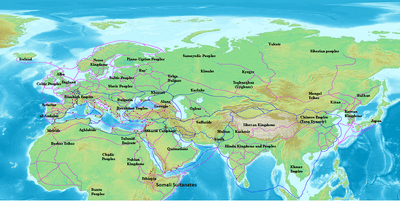
The Silk Road gave rise to the clusters of military states of nomadic origins in North China, ushered the Nestorian, Manichaean, Buddhist, and later Islamic religions into Central Asia and China, and created the influential Khazar Federation. At the end of its glory, the routes brought about the largest continental empire ever, the Mongol Empire, with its political centers strung along the Silk Road (Beijing in North China, Karakorum in central Mongolia, Sarmakhand in Transoxiana, Tabriz in Northern Iran, Sarai and Astrakhan in lower Volga, Solkhat in Crimea, Kazan in Central Russia, Erzurum in eastern Anatolia), realizing the political unification of zones previously loosely and intermittently connected by material and cultural goods.
In Central Asia, Islam expanded from the 7th century onward, bringing a stop to Chinese westward expansion at the Battle of Talas in 751. Further expansion of the Islamic Turks in Central Asia from the 10th century finished disrupting trade in that part of the world, and Buddhism almost disappeared. For much of the Middle Ages, the Islamic Caliphate (centred in the Near East) often had a monopoly over much of the trade conducted across the Old World (see Muslim age of discovery for more details).
Mongol age
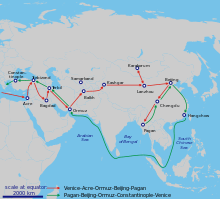
The Mongol expansion throughout the Asian continent from around 1207 to 1360 helped bring political stability and re-established the Silk Road (via Karakorum). It also brought an end to the Islamic Caliphate dominance over world trade. Because the Mongols came to control the trade routes, trade circulated throughout the region. Merchandise that did not seem valuable to the Mongols was often seen as highly valuable by the west. In return the Mongols received a large amount of luxurious goods from the West. However, they never abandoned their nomadic lifestyle. Soon after Genghis Khan died, the Silk Road was in the hands of Genghis Khans' daughters.
The Mongol diplomat Rabban Bar Sauma visited the courts of Europe in 1287–88 and provided a detailed written report back to the Mongols. Around the same time, the Venetian explorer Marco Polo became one of the first Europeans to travel the Silk Road to China, and his tales, documented in The Travels of Marco Polo, opened Western eyes to some of the customs of the Far East. He was not the first to bring back stories, but he was one of the most widely read. He had been preceded by numerous Christian missionaries to the East, such as William of Rubruck, Benedykt Polak, Giovanni da Pian del Carpine, and Andrew of Longjumeau. Later envoys included Odoric of Pordenone, Giovanni de' Marignolli, John of Montecorvino, Niccolò de' Conti, or Ibn Battuta, a Moroccan Muslim traveller, who passed through the present-day Middle East and across the Silk Road from Tabriz, between 1325–54.[46]
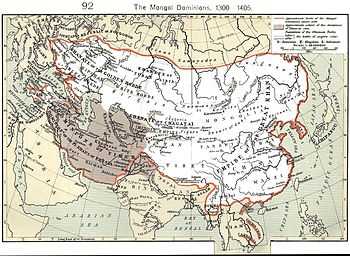
In the 13th century efforts were made at forming a Franco-Mongol alliance, with an exchange of ambassadors and (failed) attempts at military collaboration in the Holy Land during the later Crusades. Eventually the Mongols in the Ilkhanate, after they had destroyed the Abbasid and Ayyubid dynasties, converted to Islam and signed the 1323 Treaty of Aleppo with the surviving Muslim power, the Egyptian Mamluks.
Some research studies indicate that the Black Death, which devastated Europe in the late 1340s, may have reached Europe from Central Asia (or China) along the trade routes of the Mongol Empire.[47]
Disintegration
The fragmentation of the Mongol Empire loosened the political, cultural and economic unity of the Silk Road. Turkmeni marching lords seized land around the western part of the Silk Road, belonging to the decaying Byzantine Empire. After the Mongol Empire, the great political powers along the Silk Road became economically and culturally separated. Accompanying the crystallization of regional states was the decline of nomad power, partly due to the devastation of the Black Death and partly due to the encroachment of sedentary civilizations equipped with gunpowder.
Gunpowder and early modernity in Europe led to the integration of territorial states and increasing mercantilism. Meanwhile on the Silk Road, gunpowder and early modernity had the opposite impact: the level of integration of the Mongol Empire could not be maintained, and trade declined (though partly due to an increase in European maritime exchanges).
The Silk Road stopped serving as a shipping route for silk about 1453 with the Ottoman supremacy at Constantinople. Ottoman rulers of the day were anti-western, countering the crusades, and aware of the loss of Andalusia in the west, so expressed their displeasure by embargoing trade with the west. Things had eased a bit around a century later, and Venice was able to cut an uneasy deal with the Ottomans, regaining for a time some of their economic clout as middlemen.
New European Routes
The disappearance of the Silk Road following the end of the Mongols' reign was one of the main factors that stimulated the Europeans to reach the prosperous Chinese empire through another route, especially by sea. Tremendous profits were to be obtained for anyone who could achieve a direct trade connection with Asia. This was the main driving factor for the Portuguese explorations of the Indian Ocean, including the sea of China, resulting in the arrival in 1513 of the first European trading ship to the coasts of China, under Jorge Álvares and Rafael Perestrello, followed by the Fernão Pires de Andrade and Tomé Pires diplomatic and commercial mission of 1517, under the orders of Manuel I of Portugal, which opened formally relations between the Portuguese Empire and the Ming dynasty during the reign of the Zhengde Emperor. The handover of Macau (Macao) to Portugal in 1557 by the Emperor of China (as a reward for services rendered against the pirates who infested the South China Sea) resulted in the first permanent European maritime trade post between Europe and China, with other European powers following suit over the next centuries, which caused the eventual demise of the Silk Road.
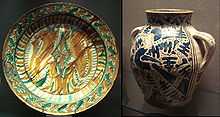
When he sailed West across the Atlantic Ocean in 1492, Christopher Columbus was searching for an alternative trade route to China from Spain.[48] When he discovered America, it was believed he had reached Asia and the search was interrupted. However, the quest for a westward route was resumed a few years later after explorer Nuñez de Balboa crossed the Isthmus of Panama in 1513 and discovered the Pacific Ocean, proving that this was in fact a New World. The voyage from Europe to Asia was finally completed with the Spanish Magellan-Elcano expedition of 1519-1522, the first European voyage to cross the Pacific Ocean and the first world circumnavigation. In 1565 Spanish navigator Andrés de Urdaneta discovered a return route across the Pacific, from the Philippines to New Spain, which led to the opening of the first regular transpacific trade route in history: the Manila-Acapulco Galleon route, which lasted two and half centuries, until 1815. This Pacific line was connected overland through Mexico with an Atlantic line, the Spanish West Indies Fleet which in turn linked the Americas with Spain, making the combined route the longest trade route in history until the 19th century, and the first example of globalization.
The desire to trade directly with China and India was the main driving force behind the expansion of the Portuguese beyond Africa after 1480, and the Spanish across the Pacific Ocean to the Philippines in 1521. Other European powers followed, namely the Netherlands and England from the 17th century onwards. In an early attempt, the Netherlands tried to find a route to Asia in 1594 but was unsuccessful. Navigator Willem Barents left Amsterdam with two ships to search for the Northeast passage north of Siberia, on to eastern Asia. He reached the west coast of Novaya Zemlya and followed it northward, being finally forced to turn back when confronted with its northern extremity. By the end of the 17th century, the Russians re-established a land trade route between Europe and China under the name of the Great Siberian Road.
While the Portuguese (and, subsequently, other Europeans) were entering China from its southern coast, by the sea route, the question arose as to whether it was the same country as Cathay which Marco had reached by the overland route. By c. 1600, the Jesuits stationed in China, led by Matteo Ricci, were pretty sure that it was, but others were not convinced. To check the situation on the ground, Bento de Góis, a Portuguese former soldier and explorer who had joined the Jesuits as a Lay Brother in Goa, India, traveled in 1603–1605 from India via Afghanistan on one of the routes of the traditional Silk Road (via Badakhshan, the Pamirs, Yarkand, Kucha, and Turpan to the border of Ming China in Suzhou, Gansu.[49]
Leibniz, echoing the prevailing perception in Europe until the Industrial Revolution, wrote in the 17th century that: Everything exquisite and admirable comes from the East Indies... Learned people have remarked that in the whole world there is no commerce comparable to that of China.
In the 18th century, Adam Smith declared that China had been one of the most prosperous nations in the world, but that it had remained stagnant for a long time and its wages always were low and the lower classes were particularly poor:[lower-alpha 1]
China has long been one of the richest, that is, one of the most fertile, best cultivated, most industrious, and most populous countries in the world. It seems, however, to have been long stationary. Marco Polo, who visited it more than five hundred years ago, describes its cultivation, industry, and populousness, almost in the same terms as travellers in the present time describe them. It had perhaps, even long before his time, acquired that full complement of riches which the nature of its laws and institutions permits it to acquire.—Adam Smith, The Wealth of Nations, 1776
Modern day
The Eurasian Land Bridge (a railroad through China, Kazakhstan, Mongolia and Russia) is sometimes referred to as the "New Silk Road". The last link in one of these two railway routes was completed in 1990, when the railway systems of China and Kazakhstan connected at Alataw Pass (Alashan Kou). In 2008 the line was used to connect the cities of Urumqi in China's Xinjiang Province to Almaty and Astana in Kazakhstan.[50]
Starting in July 2011 the line has been used by a freight service which connects Chongqing, China with Duisburg, Germany[51] which cuts travel time for cargo from about 36 days by container ship to just 13 days by freight train. As of 2013, HP is moving large freight trains of laptop computers and monitors along this rail route.[52]
Since 1993 the United Nations World Tourism Organization has been working to develop sustainable international tourism along the route with the stated goal of fostering peace and understanding.[53]
Routes
The Silk Road consisted of several routes. As it extended westwards from the ancient commercial centers of China, the overland, intercontinental Silk Road divided into northern and southern routes bypassing the Taklimakan Desert and Lop Nur.
Northern route

The northern route started at Chang'an (now called Xi'an), an ancient capital of China that was moved further east during the Later Han to Luoyang. The route was defined around the 1st century BC when Han Wudi put an end to harassment by nomadic tribes.
The northern route travelled northwest through the Chinese province of Gansu from Shaanxi Province and split into three further routes, two of them following the mountain ranges to the north and south of the Taklamakan Desert to rejoin at Kashgar, and the other going north of the Tian Shan mountains through Turpan, Talgar, and Almaty (in what is now southeast Kazakhstan). The routes split again west of Kashgar, with a southern branch heading down the Alai Valley towards Termez (in modern Uzbekistan) and Balkh (Afghanistan), while the other traveled through Kokand in the Fergana Valley (in present-day eastern Uzbekistan) and then west across the Karakum Desert. Both routes joined the main southern route before reaching ancient Merv, Turkmenistan. Another branch of the northern route turned northwest past the Aral Sea and north of the Caspian Sea, then and on to the Black Sea.
A route for caravans, the northern Silk Road brought to China many goods such as "dates, saffron powder and pistachio nuts from Persia; frankincense, aloes and myrrh from Somalia; sandalwood from India; glass bottles from Egypt, and other expensive and desirable goods from other parts of the world."[54] In exchange, the caravans sent back bolts of silk brocade, lacquer ware, and porcelain.
Southern route
The southern route or Karakoram route was mainly a single route running from China through the Karakoram mountains, where it persists to modern times as the international paved road connecting Pakistan and China as the Karakoram Highway. It then set off westwards, but with southward spurs enabling the journey to be completed by sea from various points. Crossing the high mountains, it passed through northern Pakistan, over the Hindu Kush mountains, and into Afghanistan, rejoining the northern route near Merv, Turkmenistan. From Merv, it followed a nearly straight line west through mountainous northern Iran, Mesopotamia, and the northern tip of the Syrian Desert to the Levant, where Mediterranean trading ships plied regular routes to Italy, while land routes went either north through Anatolia or south to North Africa. Another branch road traveled from Herat through Susa to Charax Spasinu at the head of the Persian Gulf and across to Petra and on to Alexandria and other eastern Mediterranean ports from where ships carried the cargoes to Rome.
Southwestern route
The southwestern route is believed to be the Ganges/Brahmaputra Delta, which has been the subject of international interest for over two millennia. Strabo, the 1st-century Roman writer, mentions the deltaic lands: "Regarding merchants who now sail from Egypt...as far as the Ganges, they are only private citizens..." His comments are interesting as Roman beads and other materials are being found at Wari-Bateshwar ruins, the ancient city with roots from much earlier, before the Bronze Age, presently being slowly excavated beside the Old Brahmaputra in Bangladesh. Ptolemy's map of the Ganges Delta, a remarkably accurate effort, showed that his informants knew all about the course of the Brahmaputra River, crossing through the Himalayas then bending westward to its source in Tibet. It is doubtless that this delta was a major international trading center, almost certainly from much earlier than the Common Era. Gemstones and other merchandise from Thailand and Java were traded in the delta and through it. Chinese archaeological writer Bin Yang and some earlier writers and archaeologists, such as Janice Stargardt, strongly suggest this route of international trade as Sichuan-Yunnan-Burma-Bangladesh route. According to Bin Yang, especially from the 12th century the route was used to ship bullion from Yunnan (gold and silver are among the minerals in which Yunnan is rich), through northern Burma, into modern Bangladesh, making use of the ancient route, known as the 'Ledo' route. The emerging evidence of the ancient cities of Bangladesh, in particular Wari-Bateshwar ruins, Mahasthangarh, Bhitagarh, Bikrampur, Egarasindhur, and Sonargaon, are believed to be the international trade centers in this route.[55][56][57]
Cultural exchanges

Richard Foltz, Xinru Liu and others have described how trading activities along the Silk Road over many centuries facilitated the transmission not just of goods but also ideas and culture, notably in the area of religions. Zoroastrianism, Judaism, Buddhism, Christianity, Manichaeism, and Islam all spread across Eurasia through trade networks that were tied to specific religious communities and their institutions.[58] Notably, established Buddhist monasteries along the Silk Road offered a haven, as well as a new religion for foreigners.[59] The spread of religions and cultural traditions along the Silk Roads, according to Jerry H. Bentley, also led to syncretism. One example was the encounter with the Chinese and Xiongnu nomads. These unlikely events of cross-cultural contact allowed both cultures to adapt to each other as an alternative. The Xiongnu adopted Chinese agricultural techniques, dress style, and lifestyle. On the other hand, the Chinese adopted Xiongnu military techniques, some dress style, and music and dance.[60]
Of all the cultural exchanges between China and the Xiongnu, the defection of Chinese soldiers was perhaps the most surprising. They would sometimes convert to the Xiongnu way of life and stay in the steppes for fear of punishment.[60]
Transmission of Christianity
Transmission of Buddhism
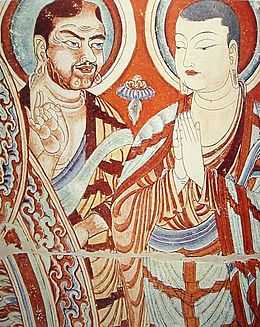
The transmission of Buddhism to China via the Silk Road began in the 1st century AD, according to a semi-legendary account of an ambassador sent to the West by the Chinese Emperor Ming (58–75 AD). During this period Buddhism began to spread throughout Southeast, East, and Central Asia.[61] Mahayana, Theravada, and Tibetan Buddhism are the three primary forms of Buddhism that spread, through the Silk Road, across Asia.[62]
The Buddhist movement was the first large-scale missionary movement in the history of world religions. Chinese missionaries were able to assimilate Buddhism, to an extent, to native Chinese Daoists, which would bring the two beliefs together.[63] Buddha's community of followers, the Sangha, consisted of male and female monks and laity. These people moved through India and beyond to spread the ideas of Buddha.[64] As the number of members within the Sangha increased, it became costly so that only the larger cities were able to afford having the Buddha and his disciples visit .[65] It is believed that under the control of the Kushans, within the middle of the first century to the middle of the third century, Buddhism was spread by the Silk Road to China as well as other parts of Asia.[66] Extensive contacts started in the 2nd century AD, probably as a consequence of the expansion of the Kushan empire into the Chinese territory of the Tarim Basin, due to the missionary efforts of a great number of Buddhist monks to Chinese lands. The first missionaries and translators of Buddhists scriptures into Chinese were either Parthian, Kushan, Sogdian or Kuchean.[67]
One result of the spread of Buddhism along the Silk Road was displacement and conflict. The Greek Seleucids were exiled to Iran and Central Asia due to a new Iranian Dynasty called the Parthians at the beginning of the 2nd century BCE, and as a result the Parthians became the new middle men for trade in a period when the Romans were major customers for silk. The Parthian scholars were involved in one of the first ever Buddhist text translations into the Chinese language, its main trade centre on the Silk Road, the city of Merv, in due course and with the coming of age of Buddhism in China, became a major Buddhist centre by the middle of the 2nd century.[68] Knowledge among people on the silk roads also increased when Emperor Ashoka of the Maurya dynasty (268–239 BCE) converted to Buddhism and raised the religion to official status in his northern Indian empire.[69]
From the 4th century onward, Chinese pilgrims also started to travel on the Silk Road to India, in order to get improved access to the original Buddhist scriptures, with Fa-hsien's pilgrimage to India (395–414), and later Xuan Zang (629–644) and Hyecho, who traveled from Korea to India.[70] The travels of the priest Xuan Zang were fictionalized in the 16th century in a fantasy adventure novel called Journey to the West, which told of trials with demons and the aid given by various disciples on the journey.

There were many different schools of Buddhism travelling on the Silk Road. The Dharmaguptakas and the Sarvastivadins were two of the major Nikaya schools. These were both eventually displaced by the Mahayana, also known as "Great Vehicle". This movement of Buddhism first gained influence in the Khotan region.[69] The Mahayana, which was more of a "pan-Buddhist movement" than a school of Buddhism, appears to have begun in north western India or Central Asia. It was small at first and formed during the 1st century BCE, and the origins of this "Greater Vehicle" are not fully clear. Some Mahayana scripts were found in northern Pakistan but the main texts are still believed to have been composed in Central Asia along the Silk Road. These different schools and movements of Buddhism were a result of the diverse and complex influences and beliefs on the Silk Road.[71] With the rise of Mahayana Buddhism, the initial direction of Buddhist development changed. This form of Buddhism highlighted, as stated by Xinru Liu "the elusiveness of physical reality, including material wealth." It also stressed getting rid of material desire to a certain point; this was often difficult for followers to understand.[72]
During the 5th and 6th centuries CE, Merchants played a large role in the spread of religion, in particular Buddhism. Merchants found the moral and ethical teachings of Buddhism to be an appealing alternative to previous religions. As a result, Merchants supported Buddhist Monasteries along the Silk Roads and in return the Buddhists gave the Merchants somewhere to stay as they traveled from city to city. As a result, Merchants spread Buddhism to foreign encounters as they traveled.[73] Merchants also helped to establish diaspora within the communities they encountered and overtime their cultures became based on Buddhism. Because of this, these communities became centers of literacy and culture with well-organized marketplaces, lodging, and storage.[74] The voluntary conversion of Chinese ruling elites helped the spread of Buddhism in East Asia. Thus, it allowed Buddhism to become widespread in Chinese society.[75] The Silk Road transmission of Buddhism essentially ended around the 7th century with the rise of Islam in Central Asia.
Transmission of art
Many artistic influences were transmitted via the Silk Road, particularly through Central Asia, where Hellenistic, Iranian, Indian and Chinese influences could intermix. Greco-Buddhist art represents one of the most vivid examples of this interaction. Silk was also a representation of art. This is because silk served as a religious symbol, and most importantly, silk was used as currency for trade along the silk road.[76]
These artistic influences can be seen in the development of Buddhism where for instance, Buddha was first depicted as human in the Kushan period. Many scholars have attributed this to Greek influence. The mixture of Greek and Indian elements can be found in later Buddhist art in China and throughout countries on the Silk Road.[77]
Commemoration
Both Bishkek and Almaty now have a major east-west street named after the Silk Road (Kyrgyz: Жибек жолу, Jibek Jolu in Bishkek, and Kazakh: Жібек жолы, Jibek Joly in Almaty). On June 22, 2014, the United Nations Educational, Scientific and Cultural Organization (UNESCO) named the Silk Road a World Heritage Site at the 2014 Conference on World Heritage.
In popular culture
Silk Road was used in the 21st century to name an online black market, while Silkcoin is a cryptocurrency.
Gallery
- Silk Road and artefacts
-
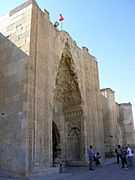
Sultanhani caravanserai
-
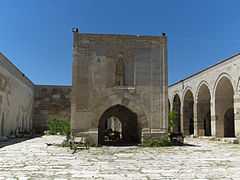
Sultanhani caravanserai
-
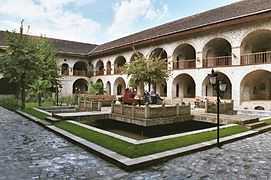
18th century caravanserai in Sheki, Azerbaijan
-
.jpg)
Selim Pass caravanserai
-
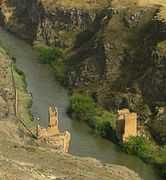
Remains of a bridge, Eastern Turkey
-
.jpg)
Taldyk pass
-
Dunhuang
-

Zeinodin Caravanserai
-

Westerner on a camel, Chinese Tang Dynasty (618-907)
-

Ancient Chinese customs post on Silk Road near Dunhuang
-

The ruins of a Han Dynasty (206 BC – 220 AD) Chinese watchtower made of rammed earth at Dunhuang, Gansu province
-
A late Zhou or early Han Chinese bronze mirror inlaid with glass, perhaps incorporated Greco-Roman artistic patterns
-
A Chinese Western Han Dynasty (202 BC – 9 AD) bronze rhinoceros with gold and silver inlay
-

Han dynasty Granary west of Dunhuang on the Silk Road.
See also
Notes
- ↑ "The accounts of all travellers, inconsistent in many other respects, agree in the low wages of labour, and in the difficulty which a labourer finds in bringing up a family in China. If by digging the ground a whole day he can get what will purchase a small quantity of rice in the evening, he is contented. The condition of artificers is, if possible, still worse. Instead of waiting indolently in their work-houses, for the calls of their customers, as in Europe, they are continually running about the streets with the tools of their respective trades, offering their service, and as it were begging employment. The poverty of the lower ranks of people in China far surpasses that of the most beggarly nations in Europe. In the neighbourhood of Canton many hundred, it is commonly said, many thousand families have no habitation on the land, but live constantly in little fishing boats upon the rivers and canals. The subsistence which they find there is so scanty that they are eager to fish up the nastiest garbage thrown overboard from any European ship. Any carrion, the carcass of a dead dog or cat, for example, though half putrid and stinking, is as welcome to them as the most wholesome food to the people of other countries. Marriage is encouraged in China, not by the profitableness of children, but by the liberty of destroying them. In all great towns several are every night exposed in the street, or drowned like puppies in the water. The performance of this horrid office is even said to be the avowed business by which some people earn their subsistence." (Adam Smith, The Wealth of Nations, 1776).
References
- ↑ Elisseeff, Vadime (2001). The Silk Roads: Highways of Culture and Commerce. UNESCO Publishing / Berghahn Books. ISBN 978-92-3-103652-1.
- ↑ Boulnois, Luce (2005). Silk Road: Monks, Warriors & Merchants. Hong Kong: Odyssey Books. p. 66. ISBN 962-217-721-2.
- ↑ Xinru, Liu, The Silk Road in World History (New York: Oxford University Press, 2010), 11.
- ↑ Jerry Bentley, Old World Encounters: Cross-Cultural Contacts and Exchanges in Pre-Modern Times (New York: Oxford University Press, 1993), 32.
- ↑ Jerry Bentley, Old World Encounters: Cross-Cultural Contacts and Exchanges in Pre-Modern Times (New York: Oxford University Press, 1993), 33.
- ↑ Waugh (2007), p. 4.
- ↑ "Approaches Old and New to the Silk Roads" Eliseeff in: The Silk Roads: Highways of Culture and Commerce. Paris (1998) UNESCO, Reprint: Berghahn Books (2009), pp. 1–2. ISBN 92-3-103652-1; ISBN 1-57181-221-0; ISBN 1-57181-222-9 (pbk)
- ↑ "Approaches Old and New to the Silk Roads" Vadime Eliseeff in: The Silk Roads: Highways of Culture and Commerce. Paris (1998) UNESCO, Reprint: Berghahn Books (2000), pp. 1–2. ISBN 92-3-103652-1; ISBN 1-57181-221-0; ISBN 1-57181-222-9 (pbk)
- ↑ Waugh, Daniel. (2007). "Richthofen's "Silk Roads": Toward the Archaeology of a Concept." The Silk Road. Volume 5, Number 1, Summer 2007, p. 4.
- ↑ Lubec, G.; J. Holauerghsrthbek; C. Feldl; B. Lubec; E. Strouhal (4 March 1993). "Use of silk in ancient Egypt". Nature 362 (6415): 25. doi:10.1038/362025b0. (also available here )
- ↑ Please refer to Royal Road.
- ↑ Prevas, John. (2004). Envy of the Gods: Alexander the Great's Ill-Fated Journey across Asia, p. 121. De Capo Press, Cambridge, Mass. ISBN 0-306-81268-1.
- ↑ "Strabo XI.XI.I". Perseus.tufts.edu. Retrieved 2011-07-13.
- ↑ Jerry H. Bentley, Old World Encounters: Cross-Cultural Contacts and Exchanges in Pre-Modern Times (New York: Oxford University Press, 1993), 54.
- ↑ The Megalithic Portal and Megalith Map. "''Silk Road, North China'', C.M. Hogan, the Megalithic Portal, ed. A. Burnham". Megalithic.co.uk. Retrieved 2011-07-13.
- ↑ Li & Zheng 2001, p. 254
- ↑ Di Cosmo,'Ancient China and its Enemies', 2002
- ↑ Ebrey (1999), 70.
- ↑ R. Ernest Dupuy and Trevor N. Dupuy, The Harper Encyclopedia of Military History from 3500 B.C. to the Present, Fourth Edition (New York: HarperCollins Publishers, 1993), 133, apparently relying on Homer H. Dubs, "A Roman City in Ancient China", in Greece and Rome, Second Series, Vol. 4, No. 2 (Oct., 1957), pp. 139–148
- ↑ Ban Chao, Britannica Online Encyclopedia
- ↑ Frances Wood, The Silk Road: Two Thousand Years in the Heart of Asia, University of California Press, 2004, ISBN 0520243404, page 46
- ↑ Jerry H. Bentley, Old World Encounters: Cross-Cultural Contacts and Exchanges in Pre-Modern Times (New York: Oxford University Press, 1993), 32.
- ↑ The Silk Roads: Highways of Commerce and Culture. Vadime Elisseeff (1998).
- ↑ Xinru Liu, The Silk Road in World History (New York: Oxford University Press, 2010), 21.
- ↑ "Strabo's Geography Book II Chapter 5 "
- ↑ Bharuch, Bharuch website, retrieved on November 19, 2013
- ↑ )Barbarikon Karachi, Sindh, Pakistan website, retrieved on November 19, 2013.
- ↑ Xinru Liu, The Silk Road in World History (New York: Oxford University Press, 2010), 40.
- ↑ Pliny the Elder, Natural Histories 11.xxvi.76
- ↑ Xinru, Liu, The Silk Road in World History (New York: Oxford University Press, 2010), 21.
- ↑ Xinru Liu, The Silk Road in World History (New York: Oxford University Press, 2010), 75.
- ↑ Xinru, Liu, The Silk Road in World History (New York: Oxford University Press, 2010), p. 20
- ↑ Seneca the Younger (c. 3 BC – 65 AD), Declamations Vol. I
- ↑ 34.0 34.1 34.2 Sogdian Trade, Encyclopedia Iranica, (retrieved 15 June 2007) <http://www.iranicaonline.org/articles/sogdian-trade>
- ↑ "Silk Road", LIVIUS Articles of Ancient History. 28 October 2010. Retrieved on 14 November 2010.
- ↑ Nishijima, Sadao (1986), "The Economic and Social History of Former Han", in Twitchett, Denis; Loewe, Michael, Cambridge History of China: Volume I: the Ch'in and Han Empires, 221 B.C. – A.D. 220, Cambridge: Cambridge University Press, pp. 545–607, ISBN 0-521-24327-0
- ↑ Eberhard, Wolfram (2005), A History of China, New York: Cosimo, ISBN 1-59605-566-9
- ↑ Whitfield, Susan (2004), The Silk Road: Trade, Travel, War and Faith, Chicago: Serindia, ISBN 1-932476-12-1
- ↑ Ebrey, Patricia Buckley (1999), The Cambridge Illustrated History of China, Cambridge: Cambridge University Press, ISBN 0-521-66991-X
- ↑ Skaff, Jonathan Karem (2009). Nicola Di Cosmo, ed. Military Culture in Imperial China. Harvard University Press. ISBN 978-0-674-03109-8.
- ↑ Sun, Guangqi (1989), History of Navigation in Ancient China, Beijing: Ocean Press, ISBN 7-5027-0532-5
- ↑ Bowman, John S. (2000), Columbia Chronologies of Asian History and Culture, New York: Columbia University Press
- ↑ Xinru Liu, The Silk Road in World History (New York: Oxford University Press, 2010), 68.
- ↑ Wink, André. Al-Hind: The Making of the Indo-Islamic World. Brill Academic Publishers, 2002. ISBN 0-391-04173-8.
- ↑ Dybo A.V., "Chronology of Türkic languages and linguistic contacts of early Türks", Moskow, 2007, p. 786,
- ↑ The Pax Mongolica, by Daniel C. Waugh, University of Washington, Seattle
- ↑ J. N. Hays (2005). "Epidemics and pandemics: their impacts on human history". p.61. ISBN 1-85109-658-2
- ↑ Arbrey, Patricia Buckley; Anne Walthall and James B. Palais (2008). East Asia: A Cultural, Social, and Political History (2nd rev ed ed.). Houghton Mifflin. p. 257. ISBN 978-0547005348.
- ↑ Henry Yule (1866), p. 530.
- ↑ "Asia-Pacific | Asia takes first step on modern 'Silk Route'". BBC News. 2009-06-22. Retrieved 2013-01-05.
- ↑ "A Silk Road for the 21st century: Freight rail linking China and Germany officially begins operations". Shanghaiist.
- ↑ Keith Bradsher (20 July 2013). "Hauling New Treasure Along the Silk Road". Retrieved 22 July 2013.
- ↑ "Objectives".
- ↑ Ulric Killion, A Modern Chinese Journey to the West: Economic Globalization And Dualism, (Nova Science Publishers: 2006), p.66
- ↑ Yang, Bin. (2008). Between Winds and Clouds: The Making of Yunnan. New York: Columbia University Press
- ↑ "History and Legend of Sino-Bangla Contacts". Fmprc.gov.cn. 2010-09-28. Retrieved 2013-04-17.
- ↑ "Holiday". Weeklyholiday.net. Retrieved 2013-04-17.
- ↑ Richard Foltz, Religions of the Silk Road, New York: Palgrave Macmillan, 2nd edition, 2010, ISBN 978-0-230-62125-1
- ↑ Xinru Liu, The Silk Road in World History (New York: Oxford University Press, 2010), 77.
- ↑ 60.0 60.1 Jerry H. Bentley, Old World Encounters: Cross-Cultural Contacts and Exchanges in Pre-Modern Times (New York: Oxford University Press, 1993), 38.
- ↑ Jerry H. Bentley, Old World Encounters: Cross-Cultural Contacts and Exchanges in Pre-Modern Times (New York: Oxford University Press, 1993), 69,73.
- ↑ James A. Anderson, China's Southwestern Silk Road in World History, World History Connected, 6, no. 1 (2009), (accessed December 2, 2013).
- ↑ Jerry Bentley, Old World Encounters: Cross-Cultural Contacts and Exchanges in Pre-Modern Times (New York: Oxford University Press, 1993), 16.
- ↑ Foltz, Richard C. (1999). Religions of the Silk Road: Overland Trade and Cultural Exchange from Antiquity to the Fifteenth Century. New York: St Martin's Press. p. 37.
- ↑ Xinru Liu, "The Silk Road in World History" (New york: Oxford University Press, 2010), pp 51.
- ↑ Xinru Liu, "The Silk Road in World History" (New York: Oxford University Press, 2010), pp 42.
- ↑ Foltz, "Religions of the Silk Road", pp. 37–58
- ↑ Foltz, Richard C. (1999). Religions of the Silk Road: Overland Trade and Cultural Exchange from Antiquity to the Fifteenth Century. New York: St Martin's Press. p. 47.
- ↑ 69.0 69.1 Foltz, Richard C. (1999). Religions of the Silk Road: Overland Trade and Cultural Exchange from Antiquity to the Fifteenth Century. New York: St Martin's Press. p. 38.
- ↑ Silkroad Foundation, Adela C.Y. Lee. "ANCIENT SILK ROAD TRAVELLERS".
- ↑ Foltz, Richard C. (1999). Religions of the Silk Road: Overland Trade and Cultural Exchange from Antiquity to the Fifteenth Century. New York: St Martin's Press. p. 41.
- ↑ Xinru Liu, "The Silk Road in World History" (New York: Oxford University Press, 2010), pp 21.
- ↑ Jerry H. Bentley, Old World Encounters: Cross-Cultural Contacts and Exchanges in Pre-Modern Times (New York: Oxford University Press, 1993), 43–44.
- ↑ Jerry H. Bentley, Old World Encounters: Cross-Cultural Contacts and Exchanges in Pre-Modern Times (New York: Oxford University Press, 1993), 48.
- ↑ Jerry H. Bentley, Old World Encounters: Cross-Cultural Contacts and Exchanges in Pre-Modern Times (New York: Oxford University Press, 1993), 50.
- ↑ Xinru, Liu,The Silk Road in World History (New York: Oxford University Press, 2010), 21.
- ↑ Foltz, Richard C. (1999). Religions of the Silk Road: Overland Trade and Cultural Exchange from Antiquity to the Fifteenth Century. New York: St Martin's Press. p. 45.
Sources
- Baines, John and Málek, Jaromir (1984): Atlas of Ancient Egypt. Oxford, Time Life Books.
- Boulnois, Luce. 2004. Silk Road: Monks, Warriors & Merchants on the Silk Road. Translated by Helen Loveday with additional material by Bradley Mayhew and Angela Sheng. Airphoto International. ISBN 962-217-720-4 hardback, ISBN 962-217-721-2 softback.
- Ebrey, Patricia Buckley. (1999). The Cambridge Illustrated History of China. Cambridge: Cambridge University Press. ISBN 0-521-66991-X.
- Foltz, Richard, Religions of the Silk Road, Palgrave Macmillan, 2nd edition, 2010, ISBN 978-0-230-62125-1
- Harmatta, János, ed., 1994. History of civilizations of Central Asia, Volume II. The development of sedentary and nomadic civilizations: 700 BC to 250. Paris, UNESCO Publishing.
- Herodotus (5th century BC): Histories. Translated with notes by George Rawlinson. 1996 edition. Ware, Hertfordshire, Wordsworth Editions Limited.
- Hopkirk, Peter: Foreign Devils on the Silk Road: The Search for the Lost Cities and Treasures of Chinese Central Asia. The University of Massachusetts Press, Amherst, 1980, 1984. ISBN 0-87023-435-8
- Hill, John E. (2009) Through the Jade Gate to Rome: A Study of the Silk Routes during the Later Han Dynasty, 1st to 2nd Centuries CE. BookSurge, Charleston, South Carolina. ISBN 978-1-4392-2134-1.
- Hulsewé, A. F. P. and Loewe, M. A. N. 1979. China in Central Asia: The Early Stage 125 BC – 23: an annotated translation of chapters 61 and 96 of the History of the Former Han Dynasty. E. J. Brill, Leiden.
- Huyghe, Edith and Huyghe, François-Bernard: "La route de la soie ou les empires du mirage", Petite bibliothèque Payot, 2006, ISBN 2-228-90073-7
- Juliano, Annettte, L. and Lerner, Judith A., et al. 2002. Monks and Merchants: Silk Road Treasures from Northwest China: Gansu and Ningxia, 4th–7th Century. Harry N. Abrams Inc., with The Asia Society. ISBN 0-8109-3478-7; ISBN 0-87848-089-7 softback.
- Klimkeit, Hans-Joach, im. 1988. Die Seidenstrasse: Handelsweg and Kulturbruecke zwischen Morgen- and Abendland. Koeln: DuMont Buchverlag.
- Klimkeit, Hans-Joachim. 1993. Gnosis on the Silk Road: Gnostic Texts from Central Asia. Trans. & presented by Hans-Joachim Klimkeit. HarperSanFrancisco. ISBN 0-06-064586-5.
- Knight, E. F. 1893. Where Three Empires Meet: A Narrative of Recent Travel in: Kashmir, Western Tibet, Gilgit, and the adjoining countries. Longmans, Green, and Co., London. Reprint: Ch'eng Wen Publishing Company, Taipei. 1971.
- Li, Rongxi (translator). 1995. A Biography of the Tripiṭaka Master of the Great Ci'en Monastery of the Great Tang Dynasty. Numata Center for Buddhist Translation and Research. Berkeley, California. ISBN 1-886439-00-1
- Li, Rongxi (translator). 1995. The Great Tang Dynasty Record of the Western Regions. Numata Center for Buddhist Translation and Research. Berkeley, California. ISBN 1-886439-02-8
- Litvinsky, B. A., ed., 1996. History of civilizations of Central Asia, Volume III. The crossroads of civilizations: 250 to 750. Paris, UNESCO Publishing.
- Liu, Xinru, 2001. "Migration and Settlement of the Yuezhi-Kushan: Interaction and Interdependence of Nomadic and Sedentary Societies." Journal of World History, Volume 12, No. 2, Fall 2001. University of Hawaii Press, pp. 261–292. .
- Liu, Li, 2004, The Chinese Neolithic, Trajectories to Early States, Cambridge UK, Cambridge University Press.
- Liu, Xinru (2010). The Silk Road in World History. Oxford University Press. ISBN 978-0-19-516174-8; ISBN 978-0-19-533810-2 (pbk).
- McDonald, Angus. 1995. The Five Foot Road: In Search of a Vanished China. HarperCollinsWest, San Francisco.
- Malkov, Artemy. 2007. The Silk Road: A mathematical model. History & Mathematics, ed. by Peter Turchin et al. Moscow: KomKniga. ISBN 978-5-484-01002-8
- Mallory, J. P. and Mair, Victor H., 2000. The Tarim Mummies: Ancient China and the Mystery of the Earliest Peoples from the West. Thames & Hudson, London.
- Ming Pao. "Hong Kong proposes Silk Road on the Sea as World Heritage", August 7, 2005, p. A2.
- Osborne, Milton, 1975. River Road to China: The Mekong River Expedition, 1866–73. George Allen & Unwin Lt.
- Puri, B. N, 1987 Buddhism in Central Asia, Motilal Banarsidass Publishers Private Limited, Delhi. (2000 reprint).
- Ray, Himanshu Prabha, 2003. The Archaeology of Seafaring in Ancient South Asia. Cambridge University Press. ISBN 0-521-80455-8 (hardback); ISBN 0-521-01109-4 (paperback).
- Sarianidi, Viktor, 1985. The Golden Hoard of Bactria: From the Tillya-tepe Excavations in Northern Afghanistan. Harry N. Abrams, New York.
- Schafer, Edward H. 1963. The Golden Peaches of Samarkand: A study of T'ang Exotics. University of California Press. Berkeley and Los Angeles. 1st paperback edition: 1985. ISBN 0-520-05462-8.
- Stein, Aurel M. 1907. Ancient Khotan: Detailed report of archaeological explorations in Chinese Turkestan, 2 vols. Clarendon Press. Oxford.
- Stein, Aurel M., 1912. Ruins of Desert Cathay: Personal narrative of explorations in Central Asia and westernmost China, 2 vols. Reprint: Delhi. Low Price Publications. 1990.
- Stein, Aurel M., 1921. Serindia: Detailed report of explorations in Central Asia and westernmost China, 5 vols. London & Oxford. Clarendon Press. Reprint: Delhi. Motilal Banarsidass. 1980.
- Stein Aurel M., 1928. Innermost Asia: Detailed report of explorations in Central Asia, Kan-su and Eastern Iran, 5 vols. Clarendon Press. Reprint: New Delhi. Cosmo Publications. 1981.
- Stein Aurel M., 1932 On Ancient Central Asian Tracks: Brief Narrative of Three Expeditions in Innermost Asia and Northwestern China. Reprinted with Introduction by Jeannette Mirsky. Book Faith India, Delhi. 1999.
- Thorsten, Marie. 2006 "Silk Road Nostalgia and Imagined Global Community". Comparative American Studies 3, no. 3: 343–359.
- Waugh, Daniel. (2007). "Richthofen "Silk Roads": Toward the Archeology of a Concept." The Silk Road. Volume 5, Number 1, Summer 2007, pp. 1–10.
- von Le Coq, Albert, 1928. Buried Treasures of Turkestan. Reprint with Introduction by Peter Hopkirk, Oxford University Press. 1985.
- Whitfield, Susan, 1999. Life Along the Silk Road. London: John Murray.
- Wimmel, Kenneth, 1996. The Alluring Target: In Search of the Secrets of Central Asia. Trackless Sands Press, Palo Alto, CA. ISBN 1-879434-48-2
- Yan, Chen, 1986. "Earliest Silk Route: The Southwest Route." Chen Yan. China Reconstructs, Vol. XXXV, No. 10. October 1986, pp. 59–62.
- Yule (translator and editor), Sir Henry (1866). Cathay and the way thither: being a collection of medieval notices of China. Issue 37 of Works issued by the Hakluyt Society. Printed for the Hakluyt society.
Further reading
- Boulnois, Luce. Silk Road: Monks, Warriors and Merchants on the Silk Road. Odyssey Publications, 2005. ISBN 962-217-720-4
- Bulliet, Richard W. 1975. The Camel and the Wheel. Harvard University Press. ISBN 0-674-09130-2.
- Christian, David (2000). "Silk Roads or Steppe Roads? The Silk Roads in World History". Journal of World History (University of Hawaii Press) 2.1 (Spring): 1.
- de la Vaissière, E., Sogdian Traders. A History, Leiden, Brill, 2005, Hardback ISBN 90-04-14252-5 Brill Publishers, French version ISBN 2-85757-064-3 on
- Elisseeff, Vadime. Editor. 1998. The Silk Roads: Highways of Culture and Commerce. UNESCO Publishing. Paris. Reprint: 2000. ISBN 92-3-103652-1 softback; ISBN 1-57181-221-0; ISBN 1-57181-222-9 softback.
- Forbes, Andrew ; Henley, David (2011). China's Ancient Tea Horse Road. Chiang Mai: Cognoscenti Books. ASIN: B005DQV7Q2
- Hansen, Valerie. The Silk Road: A New History (Oxford University Press; 2012) 304 pages; Combines archaeology and history in a study of seven oases
- Hallikainen, Saana: Connections from Europe to Asia and how the trading was affected by the cultural exchange (2002)
- Hill, John E. (2004). The Peoples of the West from the Weilüe 魏略 by Yu Huan 魚豢: A Third Century Chinese Account Composed between 239 and 265. Draft annotated English translation.
- Hopkirk, Peter: The Great Game: The Struggle for Empire in Central Asia; Kodansha International, New York, 1990, 1992.
- Kuzmina, E. E. The Prehistory of the Silk Road. (2008) Edited by Victor H. Mair. University of Pennsylvania Press, Philadelphia. ISBN 978-0-8122-4041-2
- Larsen, Jeanne. Silk Road: A Novel of Eighth-Century China. (1989; reprinted 2009)
- Levy, Scott C. "Early Modern Central Asia in World History," History Compass (Nov 2012) 10#11 866–878, DOI:10.1111/hic3.12004
- Li et al. "Evidence that a West-East admixed population lived in the Tarim Basin as early as the early Bronze Age". BMC Biology 2010, 8:15.
- Liu, Xinru, and Shaffer, Lynda Norene. 2007. Connections Across Eurasia: Transportation, Communication, and Cultural Exchange on the Silk Roads. McGraw Hill, New York. ISBN 978-0-07-284351-4.
- Miller, Roy Andrew (1959): Accounts of Western Nations in the History of the Northern Chou Dynasty. University of California Press.
- Omrani, Bijan. Asia Overland: Tales of Travel on the Trans-Siberian and Silk Road Odyssey Publications, 2010 ISBN 962-217-811-1
- Polo, Marco, Il Milione.
- Thubron, C., The Silk Road to China (Hamlyn, 1989)
- Tuladhar, Kamal Ratna (2011). Caravan to Lhasa: A Merchant of Kathmandu in Traditional Tibet. Kathmandu: Lijala & Tisa. ISBN 99946-58-91-3
- Watt, James C.Y. & Wardwell, Anne E. (1997). When silk was gold: Central Asian and Chinese textiles. New York: The Metropolitan Museum of Art. ISBN 0870998250.
- Weber, Olivier, Eternal Afghanistan (photographies of Reza), (Unesco-Le Chêne, 2002)
- Yap, Joseph P. Wars With the Xiongnu – A Translation From Zizhi Tongjian. AuthorHouse (2009) ISBN 978-1-4490-0604-4
External links
| Wikimedia Commons has media related to Silk Road. |
- Silk Road Atlas (University of Washington)
- The Silk Road, a historical overview by Oliver Wild
- The Silk Road Journal, a freely-available scholarly journal run by Daniel Waugh
- The New Silk Road – a lecture by Paul Lacourbe at TEDxDanubia 2013
| ||||||||||||||||||
| ||||||
| ||||||||||||||||||||||||||||||||
